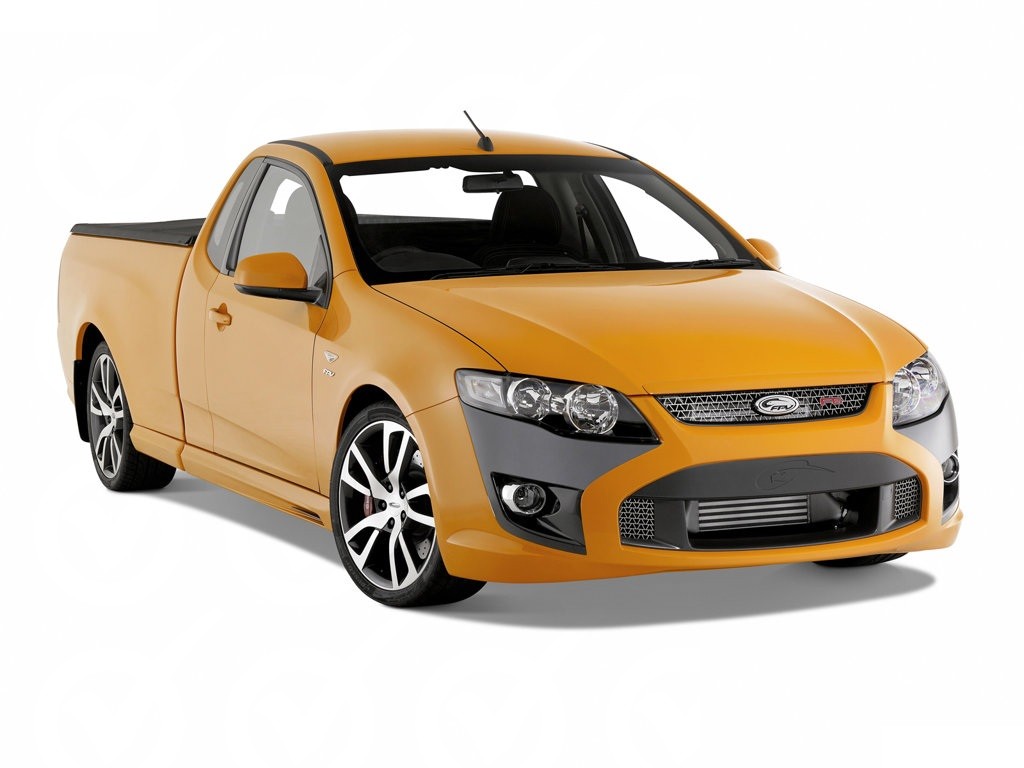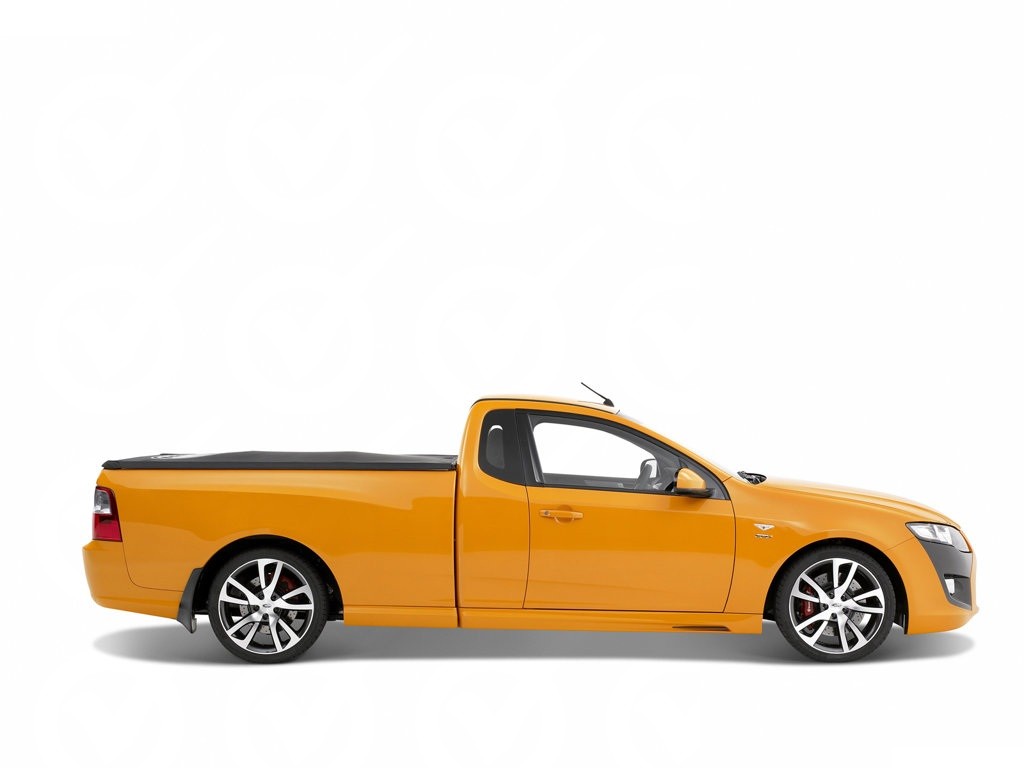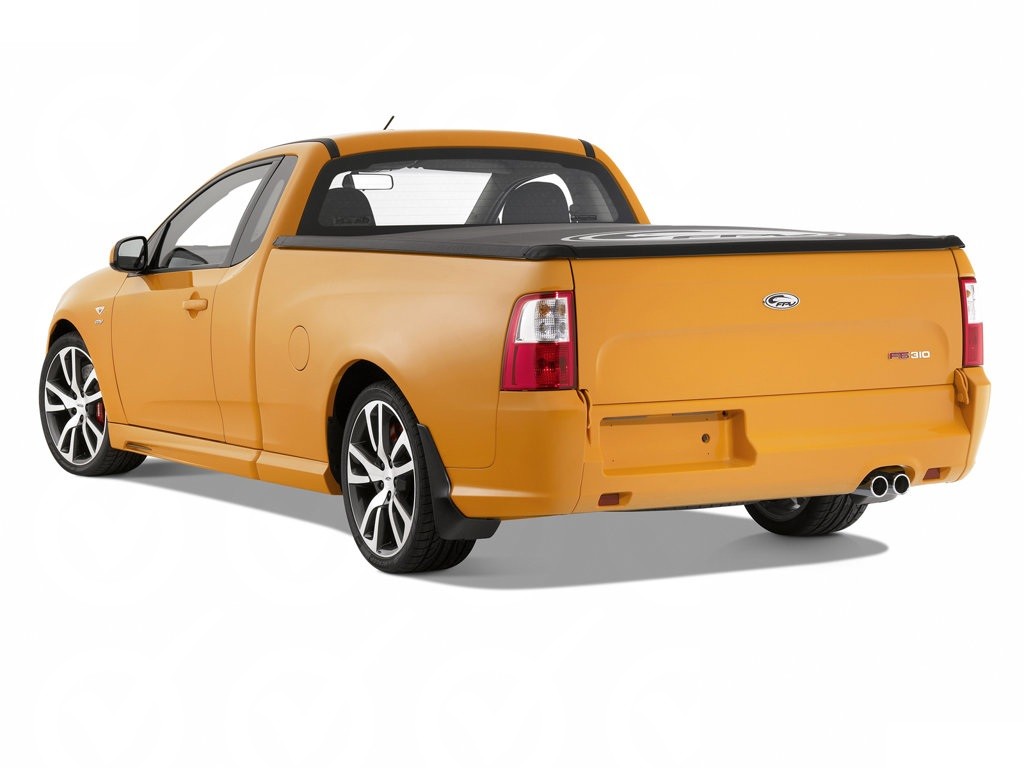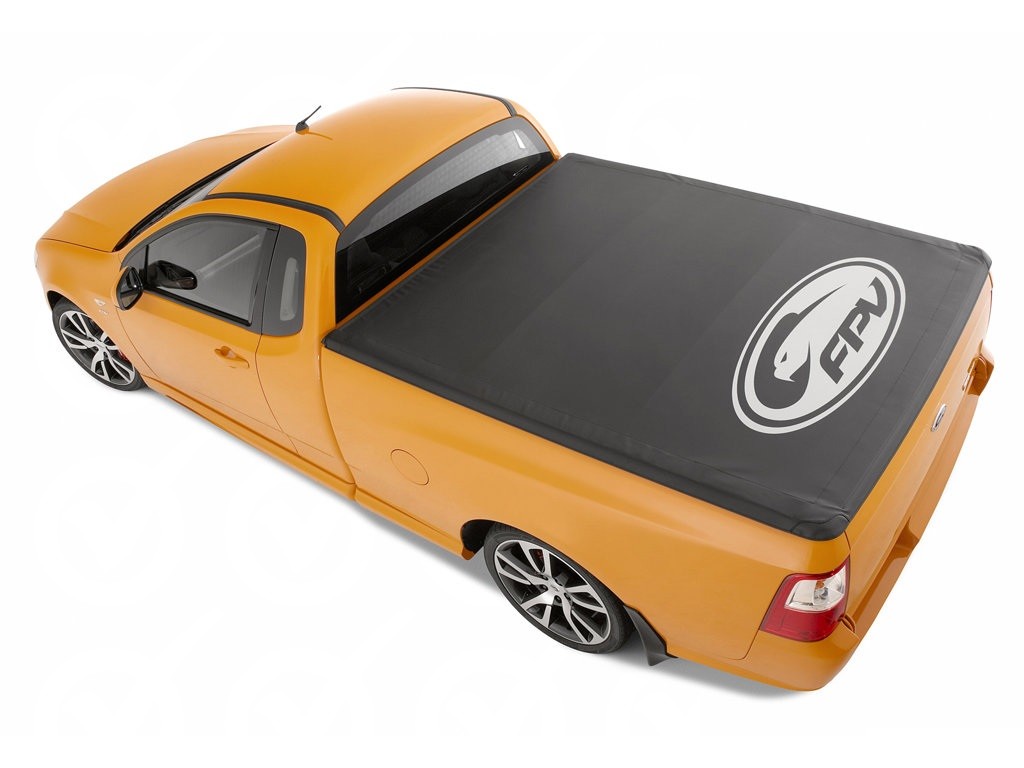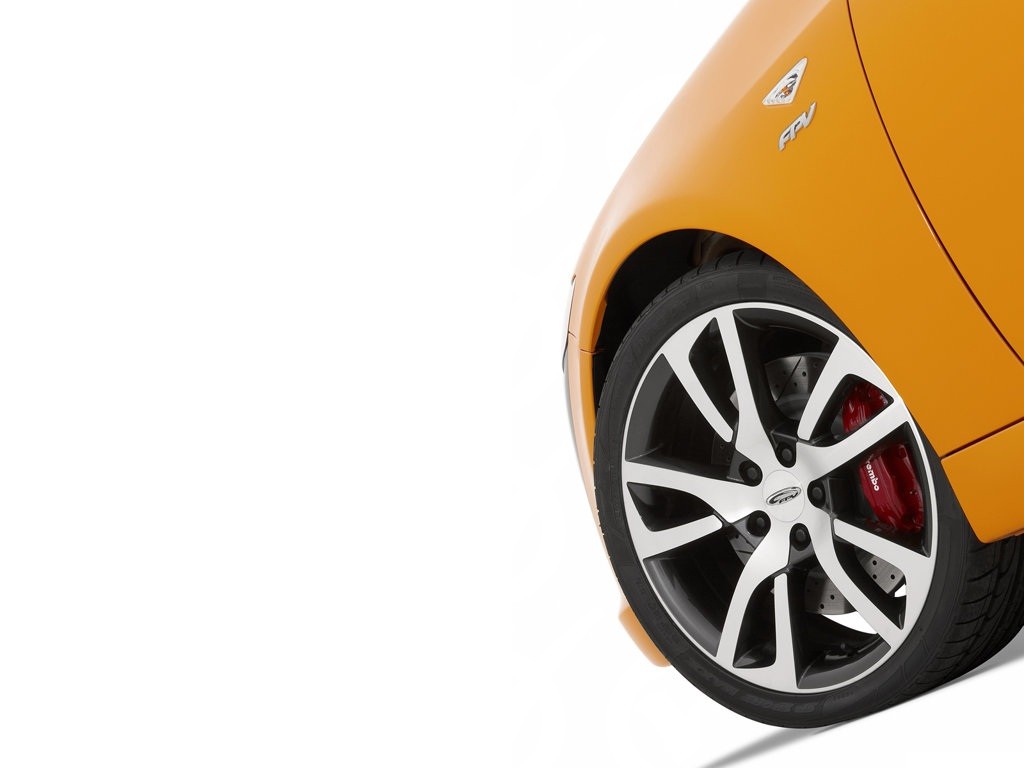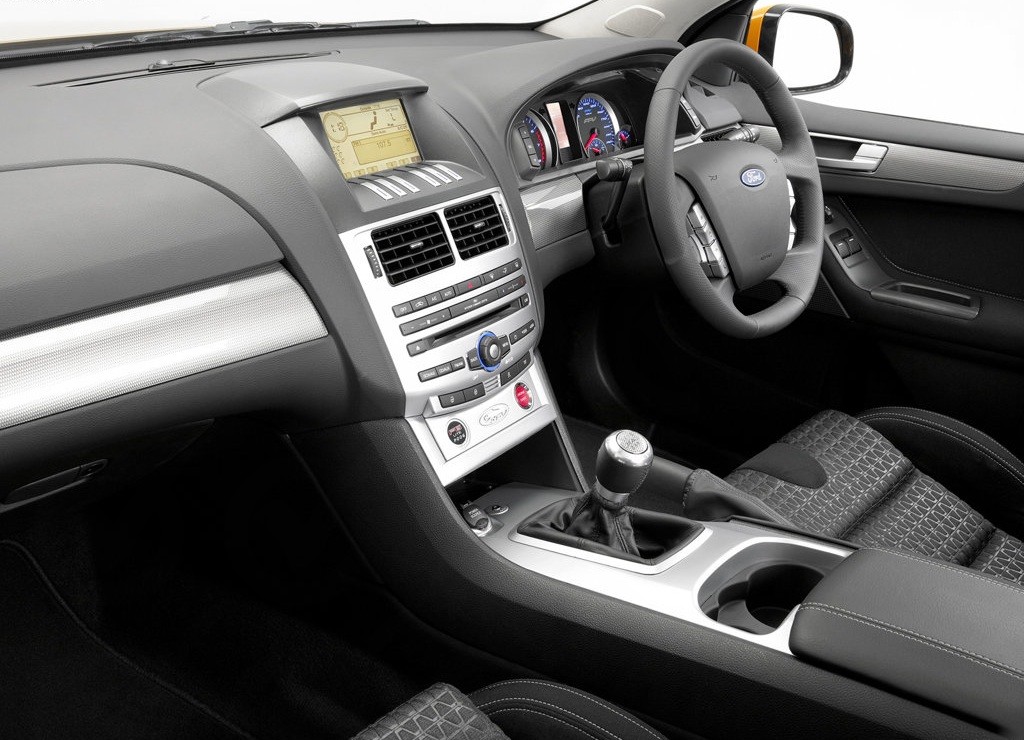
- Powerful 4.0-litre turbocharged I6 engine (310 kW and 565 Nm)
- Refined six-speed ZF automatic transmission
- Accurate, well-weighted steering
- Powerful Brembo brakes
- Generally impressive dynamics…
- … but leaf spring rear suspension struggles for traction on uneven surfaces
- For ZF transmission, coolant lines in heat exchanger were susceptible to failure
- More turbo lag than FG Falcon Ute XR6 Turbo
- Awkward driving position
- Prone to drivetrain clunks
Review: FPV FG.I F6 Ute (2008-11)
Overview
Released in May 2008, the FPV FG Mk.I (FG.I) F6 Ute was a rear-wheel drive, performance utility. Manufactured in Campbellfield, Victoria, the FPV FG F6 Ute was powered by a 4.0-litre turbocharged six cylinder petrol engine that was mated to either six-speed manual transmission or automatic transmissions. Aside from its drivetrain, the F6 Ute was similarly specified and equipped to the FPV FG Pursuit .
FPV F6 310T engine
The F6 Ute’s FPV F6 310T engine had a cast iron block, a cast aluminium cylinder head, a Garrett GT35/76R turbocharger which had engine oil-lubricated and water-cooler bearings, an air-to-air intercooler, an electronic single bypass wastegate, double overhead camshafts (DOHC, simplex chain-driven), dual independent variable camshaft timing, four valves per cylinder, Duratec-style finger followers, a dual resonance inlet manifold, coil-on-plug ignition, electronic throttle control, twin knock sensors and a compression ratio of 8.47:1.
Compared to its F6 270T predecessor, the FPV F6 310T engine had:
- New strengthened pistons and conrod assemblies;
- Revised camshaft timing;
- A new, higher efficiency Garrett GT35/76R turbocharger – developed for FPV – which had a larger compressor wheel, different compressor housing, an upgraded wastegate specification and increased boost pressure (0.91 bar, or 13.3 psi);
- A lower compression ratio (8.47:1, previously 8.7:1);
- A 22 per cent larger intercooler (by core volume) which provided a 45 per cent improvement in heat rejection and a 34 per cent reduction in pressure drop for higher air intake pressure;
- A new ‘low loss’ short path air intake system;
- A new exhaust manifold; and,
- Recalibrated engine management.
Transmissions
The FPV FG F6 was available with six-speed Tremec TR6060 manual or six-speed ZF 6HP26 automatic transmissions.
Replacing the Tremec T56 manual transmission, the Tremec TR6060 had triple synchromesh on first and second gears and double synchromesh on all other gears (including revrese) which reduced gear shift efforts and shift travel. The reduced shift travel also provided increased space for the use of larger, stronger gears for greater durability.
The FPV FG F6 Ute was fitted with the high-performance ZF 6HP26 transmission which was rated for 600 Nm applications and had upgraded clutches with extra plates in the clutch packs. For the FG range, the 6HP26 transmission had a cylinder cut function whereby the fuel injectors would be deactivated during gearshifts to reduce shift times.
Development and dimensions
Developed in conjunction with the FG Falcon Ute , the FPV F6 Ute had:
- A stronger body structure which made increased use of high-strength steels and ultra high-strength Boron steel and included a new front subframe, additional reinforcement inside the front rails, new high strength floor cross members, transmission tunnel reinforcement and a larger, stronger B-pillar;
- New Virtual Pivot Control Link front suspension (described below);
- A forward-mounted, Y-shaped steering rack with variable-ratio steering gear;
- Upgraded static sealing and triple-sealed doors;
- Larger, 81 litre fuel tanks; and,
- A self-adjusting park brake.
The F6 Ute was 5096 mm long, 1933 mm wide, 1481 mm tall and had a 3100 mm long wheelbase; kerb weight was approximately 1755 kg.
Suspension
The FPV FG F6 Ute had ‘Virtual Pivot Control Link’ front suspension which consisted of double wishbone front suspension (with two lower ball joints, an upper A-arm and virtual pivot lower control links) and a live rear axle suspended by leaf springs (both with gas-filled dampers and anti-roll bars).
The FG F6 Ute’s double wishbone front suspension had two lower ball joints that connected the separate lower arms to the suspension knuckle. These two lower links created a virtual pivot of the lower arm – hence the ‘Virtual Pivot Control Link’ name – and allowed the suspension to behave as though the lower pivot point was at the intersection of the two arms. Due to the use of aluminium and high strength steels, the Virtual Pivot Control Link suspension was 22 kg lighter than that in the BF F6 Tornado .
At the rear, the Hotchkiss rear suspension consisted of a live rear axle with leaf springs. For the FG utility range, the rear suspension was revised with stiffened three-pin leaf spring shackles.
| Engine | Years | Trans. | Peak power | Peak torque | |
|---|---|---|---|---|---|
| F6 Ute | 4.0-litre F6 310T turbo petrol I6 | 2008-11 | 6sp auto, 6sp man. |
310 kW at 5500 rpm | 565 Nm at 1950-5200 rpm |
Safety equipment
Standard safety equipment for the FPV FG F6 Ute included dual front airbags, seat-mounted head/thorax-protecting side airbags, ABS, brake assist, electronic brake force distribution, electronic stability control, traction control and front seatbelts with pretensioners and load limiters.
Brakes
The FPV F6 Ute had 355 mm by 32 mm cross-drilled and ventilated front brake discs with four-piston Brembo calipers and 328 mm by 26 mm cross-drilled and ventilated rear discs with single-piston calipers.
As an extra-cost option, the F6 Ute was available with a premium braking package which added six-piston Brembo front calipers.
ANCAP crash testing
In ANCAP crash testing , a similarly equipped FG Falcon Ute – with dual front airbags and seat-mounted head/thorax side airbags – received a five star adult occupant protection rating with a score of 33.58 out of 37. In the offset crash test, there was a slight risk of serious chest injury for the front occupants and a slight risk of serious lower leg injury for the passenger. In the side impact test, there was a slight risk of serious chest injury.
Features
Standard features for the FPV FG F6 Ute included 19-inch alloy wheels with 245/35 ZR19 Dunlop Sport Maxx tyres, a four speaker sound system with a six-disc CD player and auxiliary inputs (MP3/iPod), climate control air conditioning, a seven-inch colour display, four-way power adjustable cloth seats, cruise control with speed alert, Bluetooth connectivity, automatic headlights, a leather-wrapped steering wheel, remote central locking, power mirrors and windows, a tilt and reach adjustable steering wheel, 12 volt power outlet, trip computer, soft tonneau cover and an immobiliser.
Related links
- Specifications: FPV FG.I F6 Ute (May 2008)
- Brochure: FPV FG.I F6, FG.I F6 Ute and SY F6X (January 2009)
- Brochure: FPV FG.I Range (October 2010)
Review: FPV FG.II F6 Ute (2011-14)
Overview
Released in December 2011, the FG Mk.II (FG.II) F6 Ute introduced subtle interior and exterior updates. Inside, there was a new Interior Command Centre (ICC) with an eight-inch colour touchscreen infotainment system and auxiliary USB input for the use of memory sticks, flash drives and external powered hard drives with memory support up to 1TB.
Visually, the FG.II F6 Ute could be identified by its new lighting package with ‘precision design’ projector headlights with black bezels, five-spoke Graphite alloy wheels and sports bar.
| Engine | Years | Trans. | Peak power | Peak torque | |
|---|---|---|---|---|---|
| F6 Ute | 4.0-litre F6 310T turbo petrol I6 | 2011-14 | 6sp auto, 6sp man. |
310 kW at 5500 rpm | 565 Nm at 1950-5200 rpm |
Features
Compared to its FG.I predecessor, standard features for the FG.II F6 Ute were largely unchanged.
Brochure
Related links
